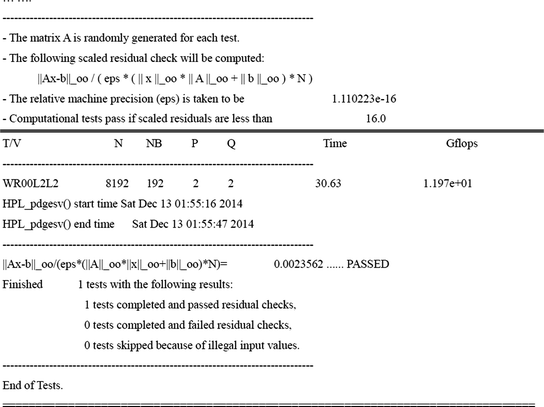

Thanks to these sites for giving me the info I needed. The overclocking issue is particularly bugging me, so will def come back to that! I might add some new nodes too. And it would be good to figure out what is going on with overclocking and OpenBLAS, to see if I can squeeze some more performance out the cluster. I might automate the build so as I add more nodes it will be easier to setup.

I’m pretty happy with what I have done here. Peak performance for my 3 node cluster was 31.322 Gflops. The biggest factor is the number and speed of CPUs, and the amount of memory! Which is about what I expected given the test type. Within the limits of my setup with only a small number of nodes, once reasonable values of P, Q and NB were established further optimisation of them yielded minimal gains. A range of variables were explored and optimised. NB: 8 16 32 64 96 128 160 192 224 256 288 320ģ Raspberry Pi 4’s were built in to a cluster and tested with High Performance Linpack. If you run out of memory the run will fail. You want to aim for memory usage between 75% and 85% which leaves some memory for the OS. Use htop or top to keep an eye on memory size during a run. If all three Pis had 8GB memory then I could have increased the problem size. Innovative Computing Laboratory, University of TennesseeĠ PMAP process mapping (0=Row-,1=Column-major)ġ BCASTs (0=1rg,1=1rM,2=2rg,3=2rM,4=Lng,5=LnM)Ġ L1 in (0=transposed,1=no-transposed) formĠ U in (0=transposed,1=no-transposed) form LAlib = $(LAdir)/lib/libf77blas.a $(LAdir)/lib/libatlas.a The variable LAdir is only used for defining LAinc and LAlib. # header files, LAlib is defined to be the name of the library to be # LAinc tells the C compiler where to find the Linear Algebra library # - Linear Algebra library (BLAS or VSIPL). The variable MPdir is only used for defining MPinc and MPlib.

# header files, MPlib is defined to be the name of the library to be # MPinc tells the C compiler where to find the Message Passing library # - HPL Directory Structure / HPL library. So we are going to make MPI, ATLAS and HPL. I also tried OpenBLAS which builds a lot quicker than ATLAS, but then I couldn’t build HPL.
LINPACK BENCHMARK CPU INSTALL
Whilst in theory you can install a linear algrebra (BLAS) library and MPI from the Raspbian repos I found that making ATLAS is much faster (on a single node, repo ATLAS gives about 5Gflops, making ATLAS from source gives about 8Gflops). You need these packages to make MPI, ATLAS and HPL High Performance Linpack. Poor application is basically just not enough! Typically during the benchmarking the CPUs never went over 40✬ with the ICE Tower Cooler and thermal paste. From thermal stickers to thermal paste is worth approx 5-10✬, where the poor application is worth approx 5✬ and good application is worth 10✬. Good application of the paste also makes a difference. On the thermal paste, it really makes a difference compared to thermal stickers that are supplied with many coolers and heatsinks. The Pi were connected to the switch in a hub and spoke pattern. Various Pi storage options (microSD and PXE boot) for the OS, see results below.
LINPACK BENCHMARK CPU SOFTWARE
I had fun.įor my simple cluster all I needed was more than one Pi, a fast network switch and some software to link the Pis over the network and to test performance. As it turns out the 3 node cluster I built would have been in the Top500 in 2003 but that’s ok. Ever since I heard of Beowulf clusters I’ve felt some geek need to build a cluster or a supercomputer.Īnd the new Raspberry Pi 4s with faster 1.5GHz CPU and up to 8GB RAM made me think I was in with a chance of building something fast. I’ve always wanted to build a cluster computer.


 0 kommentar(er)
0 kommentar(er)
